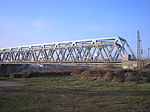Second Battle of Kehl (1796)

The Second Battle of Kehl occurred on 18 September 1796, when General Franz Petrasch's Austrian and Imperial troops stormed the French-held bridgehead over the Rhine river. The village of Kehl, which is now in the German state of Baden-Württemberg, was then part of Baden-Durlach. Across the river, Strasbourg, an Alsatian city, was a French Revolutionary stronghold. This battle was part of the Rhine Campaign of 1796, in the French Revolutionary War of the First Coalition. In the 1790s, the Rhine was wild, unpredictable, and difficult to cross. Its channels and tributaries created islands of trees and vegetation that were alternately submerged by floods or exposed during the dry seasons. A complex of bridges, gates, fortifications and barrage dams linked Kehl with Strasbourg. These had been constructed by the fortress architect Sébastien le Préstre de Vauban in the seventeenth century. The crossings had been contested before: in 1678 during the French-Dutch war, in 1703 during the War of the Spanish Succession, in 1733 during the War of the Polish Succession, and earlier in Battle of Kehl, when the French crossed into the German states on 23–24 June. Critical to French success would be the army's ability to cross the Rhine at will. The crossings at Hüningen, near the Swiss city of Basel, and at Kehl, offered access to most of southwestern Germany; from there, French armies could sweep north, south, or east, depending on their military goal. In late summer of 1796, the Austrian force reacquired most of the territory lost to the French earlier in the summer. On 18 September 1796, the Austrians temporarily acquired control of the tête-du-ponts (bridgeheads) joining Kehl and Strasbourg until a strong French counter-attack forced them to retreat, leaving the French in control of the bridges but the Austrians in control of the territory surrounding them. The situation remained in status quo until late October. Control of the surrounding territory there prevented the French from crossing to safety in Strasbourg, and required the French commander, Jean Victor Marie Moreau, to withdraw toward Basel. Immediately after the Battle of Schliengen (24 October 1796), while most of Moreau's army retreated south to cross the Rhine at Hüningen, Count Baillet Latour moved his Austrian force to Kehl to begin a 100-day siege.
Excerpt from the Wikipedia article Second Battle of Kehl (1796) (License: CC BY-SA 3.0, Authors, Images).Second Battle of Kehl (1796)
Beethovenstraße,
Geographical coordinates (GPS) Address Nearby Places Show on map
Geographical coordinates (GPS)
| Latitude | Longitude |
|---|---|
| N 48.566666666667 ° | E 7.8166666666667 ° |
Address
Beethovenstraße 42
77694 , Schneeflären
Baden-Württemberg, Germany
Open on Google Maps









